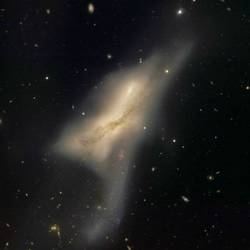
NGC 520. Image credit: Gemini Click to enlarge
In the constellation of Pisces, some 100 million light-years from Earth, two galaxies are seen to collide – providing an eerie insight into the ultimate fate of our own planet when the Milky Way fatally merges with our neighbouring galaxy of Andromeda.
The image of the intertwined galaxies was captured on the night of 13-14th July 2005 by the Gemini Multi-Object Spectrograph [GMOS] instrument fitted to the 8-metre class Gemini North Observatory, sited on Mauna Kea, Hawaii.
Prof. Ian Robson, Director of the UK Astronomy Technology Centre which built GMOS in collaboration with other partners said,” This is quite scary. Since GMOS was installed on the telescope back in 2001 it has taken some amazing astronomical images of very faint, distant galaxies and star forming regions, providing a wealth of scientific data, but this one sends shivers down my spine. Our saving grace is that we have about 5 billion years left before we get swallowed up by Andromeda. Nevertheless, it’s amazing to see so far in advance how planet Earth and our own galaxy will ultimately end. Glad to say I won’t be around when the fireball happens”.
The image of the combined galaxies, which are known as NGC 520, may be fairly early in their galactic dance of death and it is likely that the situation has changed dramatically in the time it has taken for their light to reach Earth*.
Prof. Robson added, “Hints of new star formation taking place can be seen in the faint red glowing areas above and beneath the middle of the image. Perhaps even now the galaxies have totally combined to form a whole new galaxy with a brand new set of stars and associated planets – and maybe new life on one of those planets!”
The unique shape of NGC 520 is the result of the two galaxies colliding. One galaxy’s dust lane can be seen easily in the foreground and a distant tail is visible at the bottom centre. These features are the result of the gravitational interactions that have robbed both galaxies of their original shapes.
Original Source: PPARC News Release
